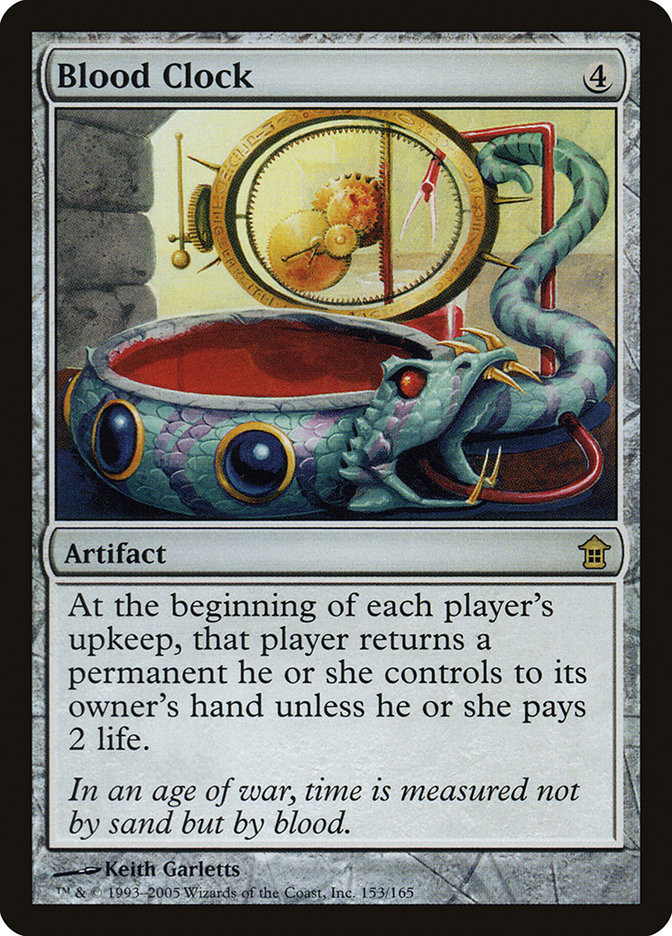Relógio de Sangue Carta MTG
| Expansões | Lançada em 2 expansõesVer todas |
| Custo de mana | |
| Custo convertido de mana | 4 |
| Raridade | Rara |
| Tipo | Artefato |
Texto da carta
No início da manutenção de cada jogador, aquele jogador devolve uma permanente que ele próprio controla para a mão de seu dono a menos que ele pague 2 pontos de vida.
Em tempos de guerra, o tempo não é medido com areia, mas sim com sangue.
Texto da carta Relógio de Sangue
No início da manutenção de cada jogador, aquele jogador devolve uma permanente que ele próprio controla para a mão de seu dono a menos que ele pague 2 pontos de vida.
Em tempos de guerra, o tempo não é medido com areia, mas sim com sangue.
Onde comprar
Se você deseja comprar um cartão Relógio de Sangue MTG de um conjunto específico como Saviors of Kamigawa and The List, há diversas opções confiáveis a serem consideradas. Uma das principais fontes é a loja de jogos local, onde muitas vezes você pode encontrar boosters, cartas individuais e decks pré-construídos de conjuntos atuais e de alguns conjuntos anteriores. Eles geralmente oferecem o benefício adicional de uma comunidade onde você pode negociar com outros jogadores.
Para um inventário mais amplo, especialmente de conjuntos mais antigos, mercados on-line como TCGPlayer, Card Kingdom e Card Market oferecem seleções extensas e permitem que você pesquise cartas de conjuntos específicos. Grandes plataformas de comércio eletrônico, como eBay e Amazon, também têm listagens de vários vendedores, o que pode ser um bom lugar para procurar produtos lacrados e achados raros.
Além disso, o site oficial do Magic geralmente tem um localizador de lojas e listas de varejistas para encontrar a Wizards of the Produtos licenciados pela Costa. Lembre-se de verificar a autenticidade e a condição dos cartões ao comprar, especialmente de vendedores individuais em mercados maiores.
Abaixo está uma lista de alguns sites de lojas onde você pode comprar os Relógio de Sangue e outras cartas MTG:
 COMPRAR
COMPRAR BurnMana é parceiro oficial da TCGPlayer
- eBay
- Card Kingdom
- Card Market
- Star City Games
- CoolStuffInc
- MTG Mint Card
- Hareruya
- Troll and Toad
- ABU Games
- Card Hoarder Magic Online
- MTGO Traders Magic Online
Veja produtos de MTG
Expansões
A carta Relógio de Sangue Magic the Gathering foi lançada em 2 expansões diferentes entre 2005-06-03 e 2005-06-03. Ilustrado por Keith Garletts.
| # | Lançamento | Nome | Código | Símbolo | Número | Moldura | Layout | Borda | Artista |
|---|---|---|---|---|---|---|---|---|---|
| 1 | 2005-06-03 | Saviors of Kamigawa | SOK | 153 | 2003 | Normal | Preta | Keith Garletts | |
| 2 | The List | PLST | SOK-153 | 2003 | Normal | Preta | Keith Garletts |
Legalidades
Magic the Gathering formats where Relógio de Sangue has restrictions
| Formato | Legalidade |
|---|---|
| Commander | Válida |
| Legacy | Válida |
| Modern | Válida |
| Oathbreaker | Válida |
| Vintage | Válida |
| Duel | Válida |
| Predh | Válida |
| Penny | Válida |
Regras e informações
O guia de referência para regras de cartas de Magic: The Gathering Relógio de Sangue fornece decisões oficiais, quaisquer erratas emitidas, bem como um registro de todas as modificações funcionais que ocorreram.
| Data | Texto |
|---|---|
| 2005-06-01 | A player who controls no permanents doesn’t need to pay 2 life (although that player can choose to do so). |
| 2005-06-01 | A player with less than 2 life can’t pay 2 life and must return a permanent. |
| 2005-06-01 | The choice of which permanent to return or whether to pay life is made as the triggered ability resolves. |

